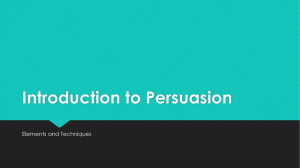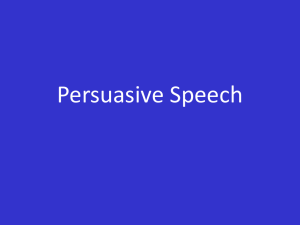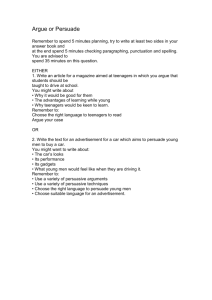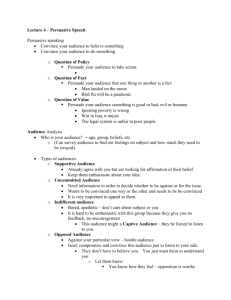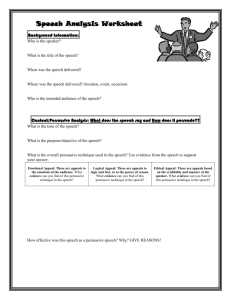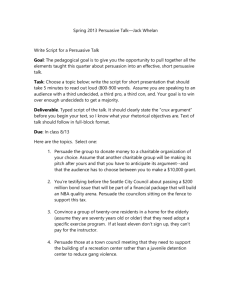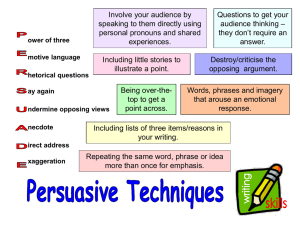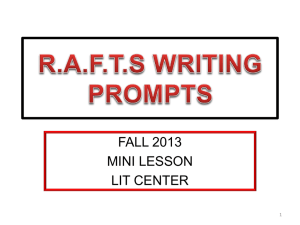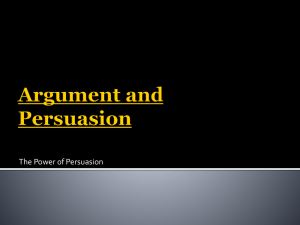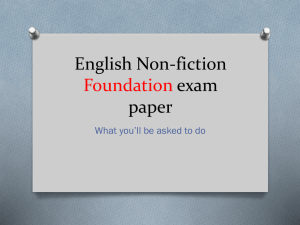PERSUASION AND ARGUMENT note 2014
advertisement
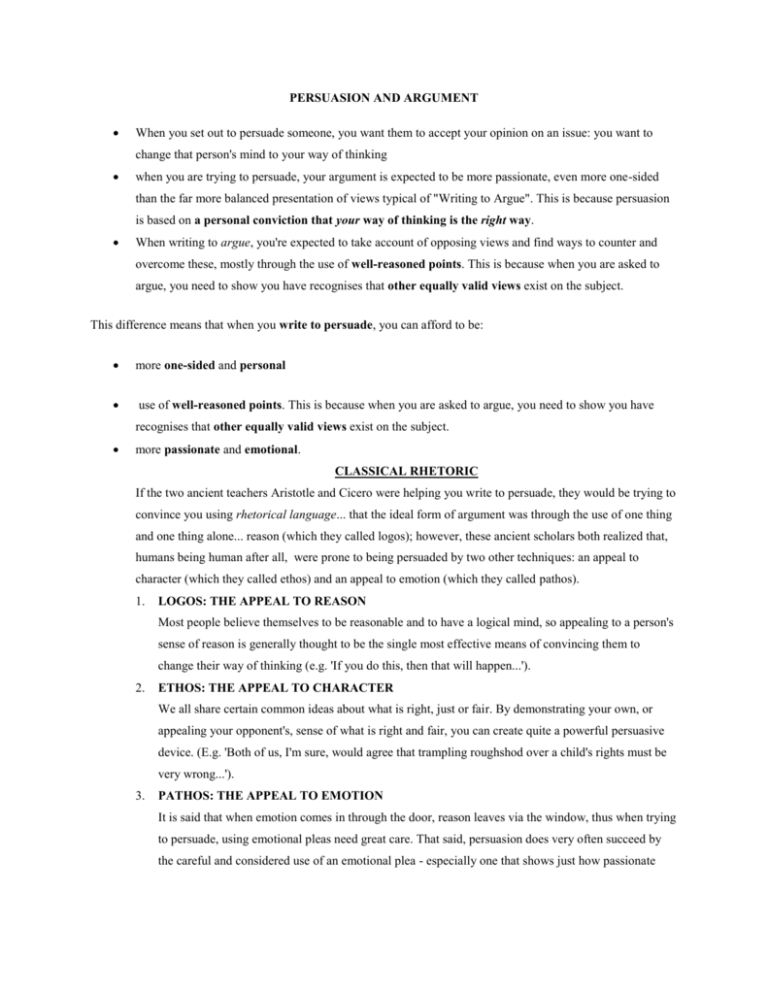
PERSUASION AND ARGUMENT When you set out to persuade someone, you want them to accept your opinion on an issue: you want to change that person's mind to your way of thinking when you are trying to persuade, your argument is expected to be more passionate, even more one-sided than the far more balanced presentation of views typical of "Writing to Argue". This is because persuasion is based on a personal conviction that your way of thinking is the right way. When writing to argue, you're expected to take account of opposing views and find ways to counter and overcome these, mostly through the use of well-reasoned points. This is because when you are asked to argue, you need to show you have recognises that other equally valid views exist on the subject. This difference means that when you write to persuade, you can afford to be: more one-sided and personal use of well-reasoned points. This is because when you are asked to argue, you need to show you have recognises that other equally valid views exist on the subject. more passionate and emotional. CLASSICAL RHETORIC If the two ancient teachers Aristotle and Cicero were helping you write to persuade, they would be trying to convince you using rhetorical language... that the ideal form of argument was through the use of one thing and one thing alone... reason (which they called logos); however, these ancient scholars both realized that, humans being human after all, were prone to being persuaded by two other techniques: an appeal to character (which they called ethos) and an appeal to emotion (which they called pathos). 1. LOGOS: THE APPEAL TO REASON Most people believe themselves to be reasonable and to have a logical mind, so appealing to a person's sense of reason is generally thought to be the single most effective means of convincing them to change their way of thinking (e.g. 'If you do this, then that will happen...'). 2. ETHOS: THE APPEAL TO CHARACTER We all share certain common ideas about what is right, just or fair. By demonstrating your own, or appealing your opponent's, sense of what is right and fair, you can create quite a powerful persuasive device. (E.g. 'Both of us, I'm sure, would agree that trampling roughshod over a child's rights must be very wrong...'). 3. PATHOS: THE APPEAL TO EMOTION It is said that when emotion comes in through the door, reason leaves via the window, thus when trying to persuade, using emotional pleas need great care. That said, persuasion does very often succeed by the careful and considered use of an emotional plea - especially one that shows just how passionate you feel for your point of view (E.g. 'Can we genuinely call ourselves human beings when we allow this kind of thing to continue unabated..?). PERSUASIVE TECHNIQUES TO USE IN AN ESSAY 1. 2. 3. 4. 5. 6. Allusion – A reference to a statement, a person, a place, or an event from literature, the arts, history, religion, mythology, politics, sports, or science Analogy – a comparison made between two things to show how they are alike. Anecdote – A very brief story, told to illustrate a point or serve as an example of something. Parallel Structure (Parallelism) – The repetition of words or phrases that have similar grammatical structures (within a sentence). Repetition – repeating words – especially in the same sentence position – to connect ideas (between two or more sentences). Rhetorical Question – A question that is asked for effect and that does not actually require an answer. 7. Facts - A powerful means of convincing, facts can come from your reading, observation, or personal experience. They are like examples, but are usually singular and observable. As with examples, persuasive writing may suffer from the selective use of facts. Note: Do not confuse facts with truths. A "truth" is an idea believed by many people, but it cannot be proven. 8. Statistics - These are facts based on numerical measurement, and can provide excellent support. Be sure your statistics come from responsible sources, and always cite your sources. Expert Testimony - Direct quotations from leading experts and/or peer-reviewed journals that support your position are invaluable. Emotional Language - Though considered biased and manipulative, emotional loaded words are commonly used to capture the feelings and sympathies of the readers. Colloquial Language - In order to be more accessible and inviting, some persuasive writers will employ a more conversational style of language. If you want to try this technique, please don't overuse it; it can become annoying and transparent, and less effective the more you use it! Poetic Devices - Some writers of persuasive texts will borrow the techniques of poetry, particularly when it comes to the sounds and meanings of words. Common techniques include alliteration, repetition, metaphors, imagery, and rhyme. Powerful Images - In less formal writing, evocative images may be selected to enhance and support an argument. 9. 10. 11. 12. 13. The different types techniques fall into three categories: 1.Emotional Appeals – speaks to a reader’s emotions through figurative language and anecdotes. 2. Logical Appeals –speaks to a reader’s common sense and logic through facts, examples, and well-reasoned arguments. 3. Ethical Appeals – addresses a readers’ sense of right and wrong through widely accepted morals, values, or beliefs.
